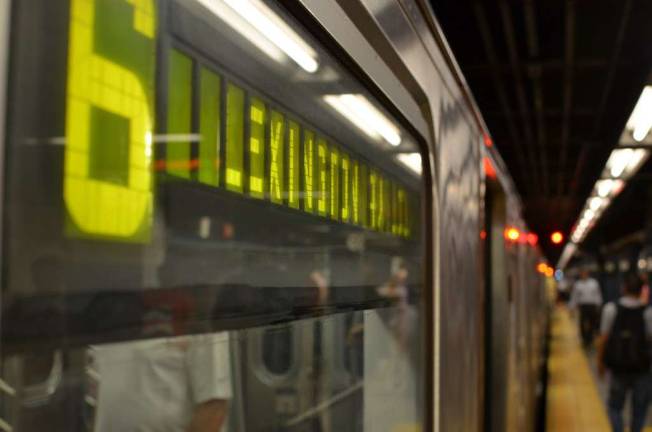Isolated East Side Subway Stabbing Prompts Fear in Some But Others Unfazed


Columbia sociologist says worry not warranted as urban violence is "quite rare"
When a deranged woman stabbed a commuter with a steak knife on the uptown 6 train last week as it was pulling into the 59th Street station, it triggered fear in some commuters. Others seemed unfazed by the seemingly random violence.
According to reports of the incident in The Daily News, Heather Burke was heading to her job as an administrator in an Upper East Side medical office when Ashley Jacob, 31, stabbed her in the shoulder and abdomen. The stabber had no apparent motive.
Burke, 39, told The News, "She didn't run, she didn't jump or say anything. She just started stabbing me." Jacob, who is homeless, also was reported to have punched another passenger in the ensuing struggle. When the train pulled into the station at 59th and Lexington, passengers streamed off warning other travelers on the platform of the danger, according to the News. Jacob was restrained by a street cleaner passing through and later by guards from the nearby Bloomingdales before being taken into custody by the NYPD. Burke was taken to New York Presbyterian/Weill Cornell Medical Center where she underwent surgery and is expected to make a full recovery.
The News reported that the same number of assaults on trains occurred in the first quarter of last year as in the first quarter of 2013, but such attacks can spark fear in the imaginations of subway riders.
Our Town visited stops along the 4, 5, 6 - including at 59th Street - to hear how riders were reacting to the news.
At the 59th Street station, where the stabbing suspect was apprehended, sisters Mary and Grace Griffin were waiting for the uptown 6, and had heard about the stabbing.
"You can't control it," said Grace Griffin, speaking of random violence. "We're retired, so it's not like we need to take [the uptown 6] all the time."
However, Mary Griffin said she always stands on the platform with her back against the wall. "I think you have to be alert all the time," she said.
Both sisters touched on how people waiting for their train are constantly on their phones, checking email or listening to music, and that the added distraction can lead to decreased vigilance.
Jerry Bell, who was waiting at the 59th Street station, said he hadn't heard about the stabbing, but isn't concerned about his safety on the subway. His friend, Mary Slagle, agreed. "We've ridden the subway, we're not fearful," said Slagle. "It's not like it was in the [19]60s."
Kat Hwang, who was waiting at the Astor Place stop and rides the 6 uptown every day, said she hadn't heard about the stabbing.
"It can happen to anyone," said Hwang, "It's New York."
While this attitude towards random acts of violence may not be surprising, sociologists explain why urban dwellers may feel blase when confronted with news of a subway stabbing.
"Paradoxically, we New Yorkers may receive more information about crime incidents via the news, but it is also very unlikely that crime will happen to us personally," said Carla Shedd, assistant professor in the Department of Sociology at Columbia University. "Urban dwellers already have so much stimuli to digest - or ignore - that it actually doesn't make much sense to worry about violence when its occurrence is actually quite rare, especially if you compare the rate of violent incidents now to the rates of the 1990s."
In a densely populated city, most people don't have the luxury of ensuring their safety when in public.
"What can you do?" said Shedd. "As a New Yorker, you likely won't be able to avoid subways or avoid other people. So, disaffect may be the most protective stance you can take along with hoping that the low probability of becoming a crime victim continues to work in your favor."
Joel Russell, who was also waiting at the Astor Place stop, said he hopes the city would have an appropriate response and increase security. He noted, however, that random acts of violence are impossible to prevent.
"You can't ever predict the behavior of a deranged person," said Buscher.
Tracy Siska, executive director of the Chicago Justice Project, a non-profit research organization that promotes evidence-based reform policy, said there's a correlation between the summer months - when it is hot - and violent crime.
The summer months bring people out of their houses, Siska said, and with kids out of school, people are "more active on the streets, in their communities, and that greater interaction leads to more interaction between people, which leads to more crime."
However, he cautioned against letting occasional random acts of violence affect policy in an urban environment.
Jennifer Beek, waiting for the 6 at Astor Place, said she hadn't heard about the stabbing but was alarmed somebody could be attacked for no reason. Beek, an interior designer who rides the subway every day, said there should be more security in the subways. "I think I'm just going to be more cautious," she said.